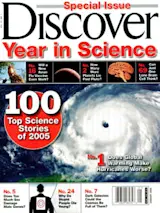Faces of Science Photographs by Mariana Cook, Intro by Gerard Piel W. W. Norton, $39.95
Humanity, humor, and wisdom grace the portraits in Mariana Cook's Faces of Science, an enchanting collection of 77 photographs. Cook's illustrious subjects include the umbrella-bearing British cosmologist Sir Martin Rees of the University of Cambridge, the wrinkle-faced late naturalist and flea expert Miriam Rothschild, and the biologist Christiane Nüsslein-Volhard (left) of the Max Planck Institute for Developmental Biology in Tübingen, Germany, who won the 1995 Nobel Prize in Physiology or Medicine for codiscovering key genes that shape embryonic development. An illuminating autobiography accompanies each portrait. Cell biologist Harold Varmus, for example, compares scientific research to cycling, his favorite sport: "Long flat intervals. Steep, sweaty, even competitive climbs. An occasional cresting of a mountain pass, with the triumphal downhill coast. Always work. Sometimes pain. Rare exhilaration."
1491: New Revelations of the Americas Before Columbus Charles C. ...














